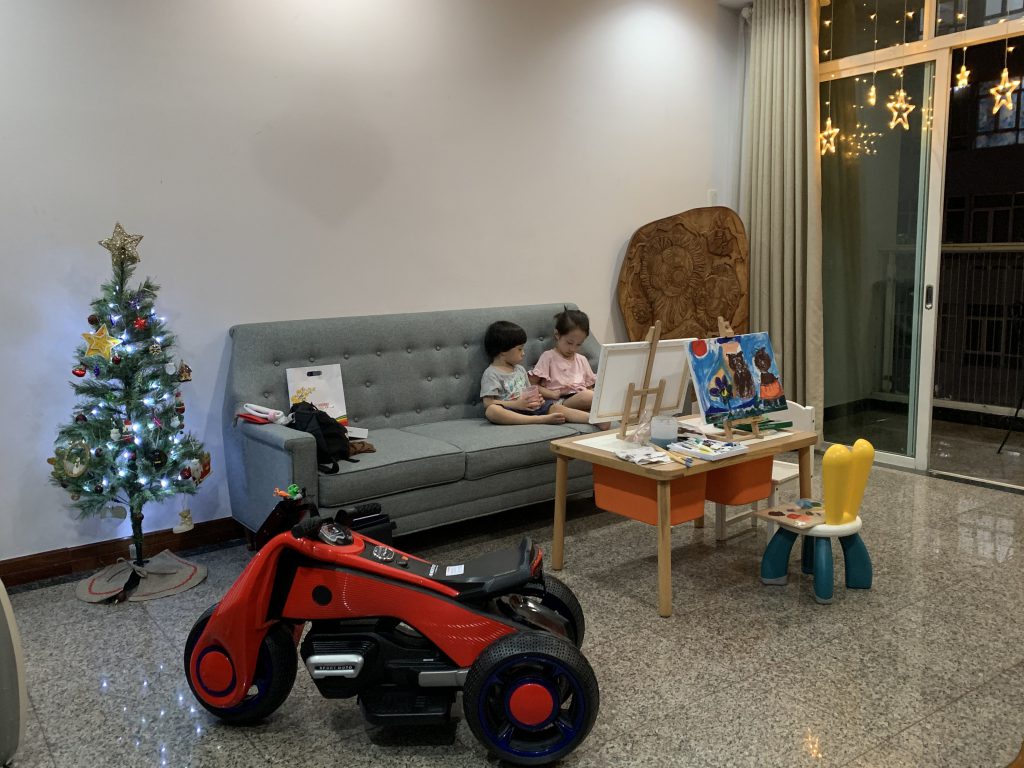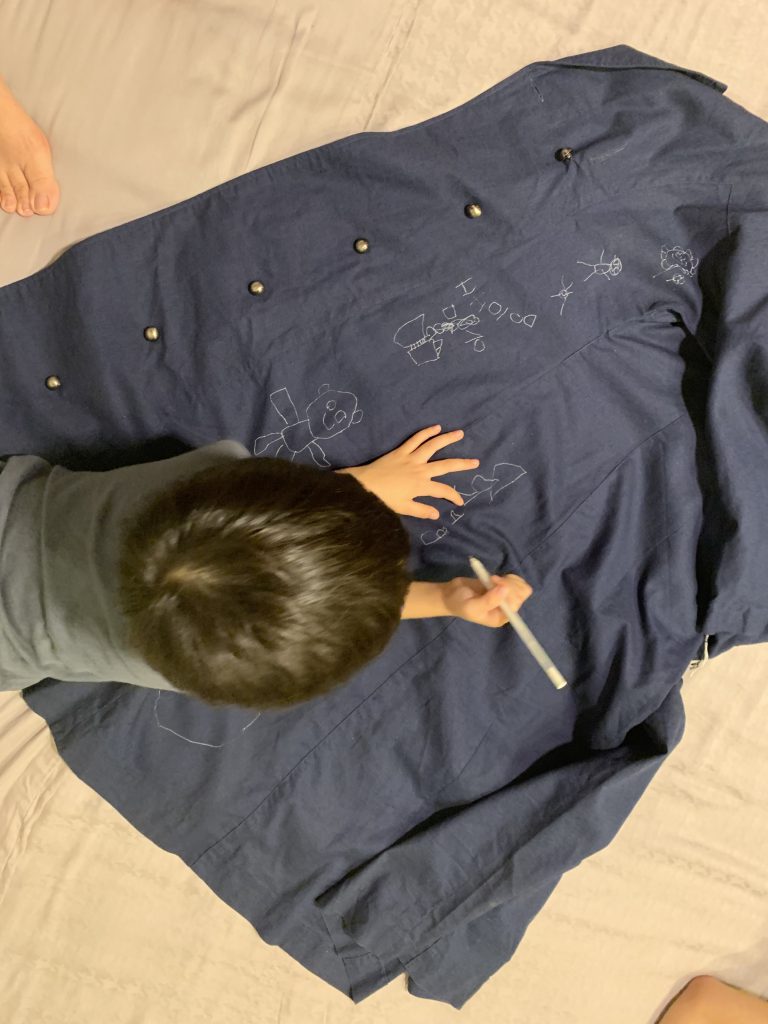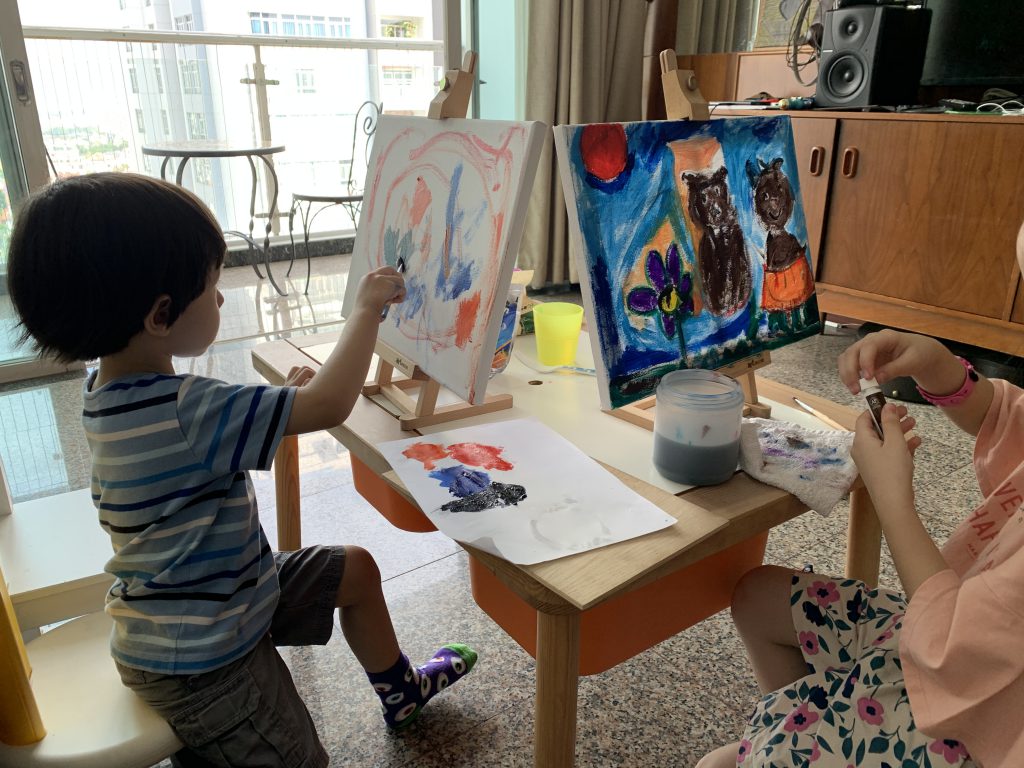CREATING ART PRACTICE SPACE AT HOME
NỘI DUNG CHÍNH:
- Lợi ích của việc tạo không gian thực hành nghệ thuật tại nhà cho con
- Hướng dẫn cách tạo lập không gian thực hành nghệ thuật tại nhà cho con
- Gợi ý hoạt động cho không gian thực hành nghệ thuật tại nhà luôn sống động

Không gian thực hành nghệ thuật tại phòng khách của gia đình nghệ sĩ thị giác Trâm Kha (hình ảnh do nghệ sĩ Trâm Kha cung cấp)
Không gian thực hành nghệ thuật tại nhà là một ý tưởng rất tuyệt vời cho các con được mơ mộng, tự do khám phá nghệ thuật. Đây cũng là nơi con có thể tự tin thể hiện “Picasso” bên trong mình. Dưới đây là một số lợi ích của việc tạo lập một không gian thực hành nghệ thuật tại nhà cho con:
LỢI ÍCH CỦA VIỆC TẠO KHÔNG GIAN THỰC HÀNH NGHỆ THUẬT TẠI NHÀ CHO CON:
- Cho con không gian và cơ hội “làm việc” tự do và an toàn, mà không bị gián đoạn: Không gian thực hành nghệ thuật tại nhà rất quan trọng đối với trẻ em – chúng mang lại cho các con cảm giác thoải mái khi biết rằng, có một nơi mà con được phép tự do và an toàn để thử nghiệm, khám phá và sáng tạo theo những cách riêng của mình. Nơi mà con được đáp ứng bản năng tò mò tự nhiên của mình và được thỏa sức đắm mình vào thế giới tưởng tượng và dòng chảy sáng tạo (creative flow) mà không bị gián đoạn. Bên cạnh đó, không gian này còn khuyến khích trẻ tham gia vào những hoạt động sáng tạo một cách thoải mái và tự tin vì các con biết rằng mình có thể thoải mái sử dụng các loại vật liệu và dụng cụ nghệ thuật. Từ đó, con sẽ hình thành và phát triển sự tự tin vào khả năng sáng tạo và tin vào những ý tưởng của mình, qua những lần khám phá và trải nghiệm những vật liệu nghệ thuật ấy.
- Khuyến khích phát triển tư duy thực hành nghệ thuật và nuôi dưỡng khía cạnh nghệ thuật bên trong con: Với không gian đặc biệt này, con được tự mình thử nghiệm và khám phá các nguyên vật liệu, được kiên trì, hăng say thực hành nghệ thuật, phát triển tác phẩm của mình bằng nhiều cách khác nhau. Điều này phát triển ở con tư duy thực hành nghệ thuật như những hoạ sĩ, nghệ sĩ thị giác. Thông qua việc tham gia vào các giai đoạn trong quá trình sáng tạo. Các con dần phát triển trí tò mò, đạt được những hiểu biết mới về các khái niệm và khám phá về cách mà vạn vật vận hành. Ngoài ra, với không gian này, các con được rèn luyện về cách quản lý và tổ chức không gian thực hành nghệ thuật. Điều này thể hiện qua việc con biết được cách cất giữ đồ dùng, dọn dẹp sạch sẽ không gian,… trong và sau khi con đã thực hành xong. Từ đó, con dần phát triển ý thức và thói quen giữ gìn vệ sinh, bảo quản đồ dùng, tổ chức không gian,… ở những khu vực khác trong nhà hay ở một môi trường khác.
- Gắn kết các thành viên trong gia đình: Thực hành nghệ thuật tạo cơ hội để ba mẹ và con có thêm thật nhiều khoảng thời gian chất lượng với nhau. Ba mẹ có thể quan sát từ xa hoặc ngồi cùng con để tham gia vào các hoạt động sáng tạo của con mình để thấu hiểu và kết nối nhau hơn. Khi lắng nghe chia sẻ và những ý tưởng của con thể hiện qua nhiều ngôn ngữ khác, ba mẹ có thể hiểu hơn về thế giới nội tâm, về sở thích và điều con quan tâm, về thói quen suy nghĩ,… Đối với trẻ em, khi được người lớn chú tâm lắng nghe mình, các con cũng sẽ thấy những ý tưởng cũng như bản thân mình quan trọng, giúp con phát triển sự tự tin sáng tạo cùng sự tự tôn.
Ba mẹ đã có ý tưởng nào để tạo lập một không gian thực hành nghệ thuật tại nhà cho con mình chưa? Dưới đây, VCVAA sẽ giới thiệu một số gợi ý để ba mẹ có thể tạo lập “góc nhỏ” này trong ngôi nhà của mình.
HƯỚNG DẪN TẠO LẬP KHÔNG GIAN THỰC HÀNH NGHỆ THUẬT TẠI NHÀ
6 gợi ý để tạo lập không gian thực hành nghệ thuật tại nhà:
1. Cùng con tìm và chọn ra một không gian thoải mái: Hãy bảo đảm rằng nơi này có đầy đủ ánh sáng, không gian có sự riêng tư nhưng nằm trong tầm quan sát của ba mẹ. Không gian này cũng nên gần với khu vực vệ sinh hoặc bồn rửa tay. Nếu không, ba mẹ chỉ cần đặt những chậu nước nhỏ ở gần đó để khi thực hành nghệ thuật xong, các con có thể rửa tay và rửa sạch các hoạ cụ như cọ, bảng màu, ly đựng,… một cách dễ dàng. Ba mẹ cũng đừng quên rằng, nên tránh đặt những đồ vật trang trí được làm bằng thủy tinh hoặc bằng gốm xung quanh khu vực này. Vì chúng dễ vỡ, có thể gây thương tích nghiêm trọng cho các con.
Không gian sáng tạo không nhất thiết phải là hoặc gắn với không gian học tập của con. Và đôi khi, để thay đổi niềm cảm hứng nghệ thuật, ba mẹ có thể cho con được cho con được thay đổi không gian thực hành nghệ thuật như ra ngoài sân để vẽ hoặc chơi màu, ngồi trên bàn ăn để vừa thực hành vừa trò chuyện cùng gia đình,…
2. Bố trí bàn ghế: Bàn ghế là không thể thiếu để con được thực hành thoải mái. Ba mẹ hãy lựa chọn bàn ghế phù hợp với độ cao của con, tránh chọn bàn ghế quá cao hoặc quá thấp vì sẽ làm ảnh hưởng đến cột sống của con khi con ngồi không đúng tư thế. Bàn ghế có chiều cao phù hợp khi: bàn chân của con đặt phẳng trên sàn nhà và đầu gối hướng xuống đất một góc 90 độ. Ngoài ra, mặt bàn nên cần đủ to, rộng và phẳng để con có thể đặt giấy vẽ, màu, bút,…thật thoải mái. Với những loại bàn khó vệ sinh, ba mẹ cũng có thể bổ sung thêm những loại bảng to để lót phía dưới, để tiết kiệm hơn ba mẹ có thể mua những loại giấy xi măng mỏng hoặc giấy báo cũ để lót bàn khi các con thực hành nghệ thuật.
3. Bổ sung và cung cấp các nguyên vật liệu: Trẻ em luôn tò mò và yêu thích tương tác với nhiều loại chất liệu, dụng cụ khác nhau. Các con thích thú khám phá việc có thể làm gì với mỗi loại chất liệu. Vì thế, ba mẹ hãy chuẩn bị đa dạng các nguyên vật liệu cho con được trải nghiệm tại không gian này nhưng không nhất thiết phải cùng một lúc. Ba mẹ có thể thay đổi nguyên vật liệu cho con mỗi 5-7 tuần một lần, do các con cần có thời gian được. Các nguyên vật liệu đơn giản và có thể dễ dàng tìm được ở bất kỳ nhà sách nào như: Phấn không bụi, màu sáp, màu sáp dầu, màu Marker, màu Poster, màu Tempera, màu nước, đất nặn, giấy… Sẽ có một vài nguyên vật liệu không an toàn với trẻ nhỏ, nó có thể ảnh hưởng tới hô hấp hoặc nhạy cảm với da của con. Thế nên ba mẹ hãy lưu ý khi mua những hoạ cụ này và đảm bảo rằng nó không chứa chất độc hại bằng cách kiểm tra hoạ cụ có con dấu AP (Approved Product) hay không. Con dấu này xác định các vật liệu nghệ thuật là an toàn và được chứng nhận trong đánh giá chất độc bởi các chuyên gia y tế để không chứa vật liệu với số lượng đủ để gây độc hoặc gây thương tích cho con người, kể cả trẻ em hoặc gây ra các vấn đề sức khỏe cấp tính hoặc mãn tính. Đây là con dấu chứng nhận Art and Creative Materials Institute (ACMI). Ngoài ra, các nguyên vật liệu dễ tìm thấy được trong nhà như: giấy báo, giấy bạc, vải, kim chỉ,.. cũng là những loại chất liệu nghệ thuật thú vị để con có thể khám phá. Ba mẹ hãy tái sử dụng các đồ dùng trong nhà như hộp giấy, hộp nhựa, ly nhựa,.. để làm đồ đựng dụng cụ và nguyên vật liệu. Thật ra, bất cứ chất liệu/ vật liệu nào trong đời sống cũng có tiềm năng trở thành chất liệu nghệ thuật của 1 dự án/ tác phẩm nên ba mẹ không nhất thiết chỉ thu hẹp về danh sách các chất liệu dùng trong sáng tác nghệ thuật. Và đó cũng là yếu tố khác biệt giữa sáng tạo tại nhà và thực hành nghệ thuật tại trường.
 Ví dụ như, ba mẹ cũng có thể soạn ra những chiếc áo, váy,… cũ để các bạn được thử nghiệm vẽ và làm mới chúng (Hình ảnh do Nghệ sĩ thị giác Trâm Kha cung cấp).
Ví dụ như, ba mẹ cũng có thể soạn ra những chiếc áo, váy,… cũ để các bạn được thử nghiệm vẽ và làm mới chúng (Hình ảnh do Nghệ sĩ thị giác Trâm Kha cung cấp).
4. Cá nhân hoá không gian bằng cách trang trí để phù hợp với con: Ba mẹ hãy cùng con trang trí không gian này bằng cách treo những bức tranh mà con yêu thích. VCVAA khuyến khích ba mẹ trưng ảnh chụp hoặc những tranh có hình khối cơ bản. Ba mẹ không nên treo tranh có hình vẽ cụ thể vì có thể mang tính tạo khuôn mẫu làm ảnh hưởng đến sự sáng tạo của con. Bên cạnh đó, ba mẹ hãy cùng lên ý tưởng và thiết kế những nhãn dán cho các hộp đựng đồ dùng. Và hãy để con được bố trí, sắp đặt các đồ dùng, họa cụ theo cách mà con muốn tại “góc nhỏ” của mình. Điều này không những giúp con tự tạo được không gian của riêng bản thân mình mà còn xây dựng ở con thói quen tôn trọng, giữ gìn, cất giữ đồ dùng, dụng cụ đúng chỗ sau khi sử dụng.
5. Chọn một nơi để làm “trạm trưng bày” sản phẩm và nơi lưu trữ các sản phẩm nghệ thuật của con: Đừng quên trưng bày các tác phẩm nghệ thuật của con trong không gian sáng tạo này. Các con rất thích sống giữa những “biểu hiện nghệ thuật” của riêng mình, và thật ý nghĩa sao nếu các tác phẩm nghệ thuật của con được treo lên cho mọi người có thể chiêm ngưỡng. Điều này cho con thấy được, việc thực hành nghệ thuật là có ý nghĩa và sẽ không có bức tranh nào của con bị lãng quên.
6. Nghỉ ngơi và thư giãn: Sáng tạo không phải lúc nào cũng là tạo ra mọi thứ. Đôi khi các con cần có cơ hội để thu thập một chút nguồn cảm hứng. Nếu có thể, ba mẹ hãy đặt một số ghế ngồi, gối, võng để con có thể thư giãn khi xem sách nghệ thuật và không còn gì tuyệt vời hơn khi ở nơi đây còn có cả âm nhạc.
GỢI Ý CÁC CÁCH DUY TRÌ HOẠT ĐỘNG TẠI KHÔNG GIAN THỰC HÀNH NGHỆ THUẬT
Có 3 cách để duy trì hoạt động tại “góc nhỏ” này cùng con:
Thứ 1: Hình thành các thói quen thực hành nghệ thuật:
Việc hình thành thói quen thực hành nghệ thuật rất quan trọng trong việc nuôi dưỡng ở trẻ niềm đam mê, yêu thích nghệ thuật. Để hình thành thói quen này, ba mẹ hãy cho con được chọn một hoặc nhiều khoảng thời gian cố định trong tuần, thời gian có thể kéo dài từ 45 phút đến 1 tiếng để cho con được tự do khám phá, vọc vạch các loại chất liệu khác nhau, và được thỏa sức sáng tạo ở “góc nhỏ” này. Ngoài ra, ba mẹ có thể chọn khoảng thời gian cuối tuần cố định để cùng con thực hành nghệ thuật. Đôi khi, cùng con khám phá các chất liệu mới, cùng con trò chuyện và vẽ cùng nhau. Cũng tạo một khoảng thời gian thoải mái, gắn kết với nhau sau một tuần làm việc và học tập bận rộn.
Thứ 2: Thay đổi NVL/ hướng dẫn con cách chơi và sử dụng NVL đó theo thời gian nhất định:
Trẻ em luôn thích tương tác với nhiều loại chất liệu khác nhau. Các con thích thú khám phá việc có thể làm gì với mỗi loại chất liệu. Và có một sự thật thú vị rằng, trẻ nhỏ cũng rất thích sự lặp lại, vì vậy ba mẹ có thể để các con được khám phá một loại chất liệu nghệ thuật cụ thể nhiều lần. Vào những ngày đầu tiên khi khám phá chất liệu mới, ba mẹ hãy cho con được khám phá và cảm nhận về các đặc điểm, tính chất, sự biến đổi dạng thức của chất liệu đó. Để từ đó con nhận ra độ dẻo dai của đất nặn, độ bền cứng của đá, độ mỏng nhẹ của giấy,… khơi dậy trong con niềm yêu thích, kết nối với chất liệu đó. Tiếp đến, hãy cung cấp cho con các công cụ, dụng cụ để con chơi cùng. Khi con tự tin sử dụng các công cụ một cách thuần thục con sẽ dễ dàng thể hiện được những ý tưởng trong đầu qua sản phẩm nghệ thuật của mình. Ví dụ như khi con biết sử dụng kéo thuần thục, những đường cắt sẽ trở nên sắc sảo hơn, mềm mại và uyển chuyển.
Thứ 3: Trò chuyện về các sản phẩm nghệ thuật cùng con:
Việc lắng nghe và trò chuyện về các tác phẩm nghệ thuật của con cũng là điều quan trọng để ba mẹ có thể kết nối với con mình thông qua nghệ thuật. Ba mẹ hãy lắng nghe và trò chuyện cùng con về những khó khăn mà con đã gặp phải, cùng cách mà con vượt qua chúng khi thực hiện tác phẩm về những câu chuyện ấm áp thú vị đằng sau những hình thái mà không thể nhìn thấy hay chạm tới được. Ba mẹ có thể thử các cách trò chuyện dưới đây để có thể hiểu hơn về tác phẩm của con mình nhé:
- Hỏi về tác phẩm: Ba mẹ hãy đặt câu hỏi mở để con được thỏa sức chia sẻ về những chủ đề và nội dung của bức tranh/ mô hình, cùng quá trình con tạo nên tác phẩm đó. Ví dụ như: “Con đã vẽ/tạo nên tác phẩm gì vậy? Con đã sử dụng gì để vẽ/tạo nên tác phẩm này?” “Hãy kể cho ba mẹ nghe về tác phẩm của con nha!”
- Phát triển câu chuyện: Tiếp tục đặt những câu hỏi dựa trên thông tin mà con chia sẻ về chủ đề của bức tranh/ mô hình để tiếp tục trò chuyện và phát triển trí tưởng tượng của con. VD: “Bạn gấu mà con vẽ đang làm gì đấy nhỉ?” “Bạn ấy đang cảm thấy thế nào?” “Bạn ôtô này đang đi đâu vậy?”
- Khuyến khích, khen ngợi: Mô tả thật cụ thể một điều mà ba mẹ quan sát được và hỏi con cách thức mà con đã thực hiện cùng lý do con chọn cách làm đó. Khích lệ con tiếp tục phát huy thực hiện thêm các tác phẩm khác. “Ba/mẹ thích cách con vẽ cái bánh xe to thật to! Chắc là chiếc xe này chạy nhanh lắm đây. Con đã vẽ bánh xe này như thế nào?” “Tiếp theo bạn xe sẽ đi tới đâu nhỉ? Con có muốn ngày mai mình cùng vẽ chiếc xe này đến vùng đất mới không?”
Hi vọng với những gợi ý trên đây. Ba mẹ đã rút ra một số kiến thức và có thể tìm được một không gian thực hành nghệ thuật tại nhà phù hợp cho con mình. Đây chỉ là những gợi ý nhỏ từ VCVAA, VCVAA tin rằng ba mẹ là chính là người hiểu con nhất. Thế nên, ba mẹ hãy tự do cùng con xây dựng “góc nhỏ nghệ thuật” này tại nhà nhé!
NGUỒN THAM KHẢO CHO BÀI VIẾT:
Kinder Art (2023). Creative Spaces for Kids. Link: https://kinderart.com/blog/creative-spaces-kids/
Life as a human (2012). The Importance of Creative Spaces for Kids. Link: https://lifeasahuman.com/2012/arts-culture/creativity/the-importance-of-creative-spaces-for-kids/
Stories Of Play. A Dedicated Art Space in the Home (Part 2) – 10 Skills Children Gain From Having A Space to Create Independently. Link: https://storiesofplay.com/a-dedicated-art-space-in-the-home-part-2-10-skills-children-gain-from-having-a-space-to-create-independently/
Kids in the house (2023). Creating a Special Space for Your Kids to Learn and Play. Link: https://www.kidsinthehouse.com/blogs/tracey-clayton/creating-a-special-space-for-your-kids-to-learn-and-play
Childhood 101 (2022). 5 Tips for Connecting With Kids Through Art…Without the Overwhelm. Link: https://childhood101.com/connecting-with-kids-through-art/
Ecokid Art (2023). Design Kids Art Making Space – Home Organizing Tips. Link: https://www.ecokidsart.com/12350-2/
Wirecutter (2023). How to Make Space for Kids to Be Creative at Home. Link: https://www.nytimes.com/wirecutter/blog/creative-kids-space-at-home/
LittleArt Club (2023). How to Incorporate Art Into Your Child’s Daily Routine: A List of Creative Activities. Link: https://littleart.club/how-to-incorporate-art-into-your-childs-daily-routine-a-list-of-creative-activities/



